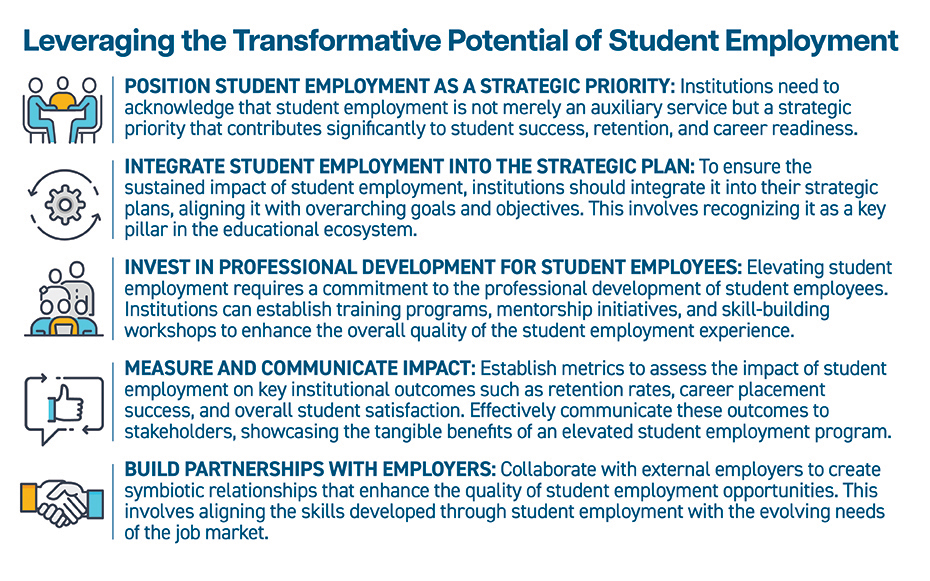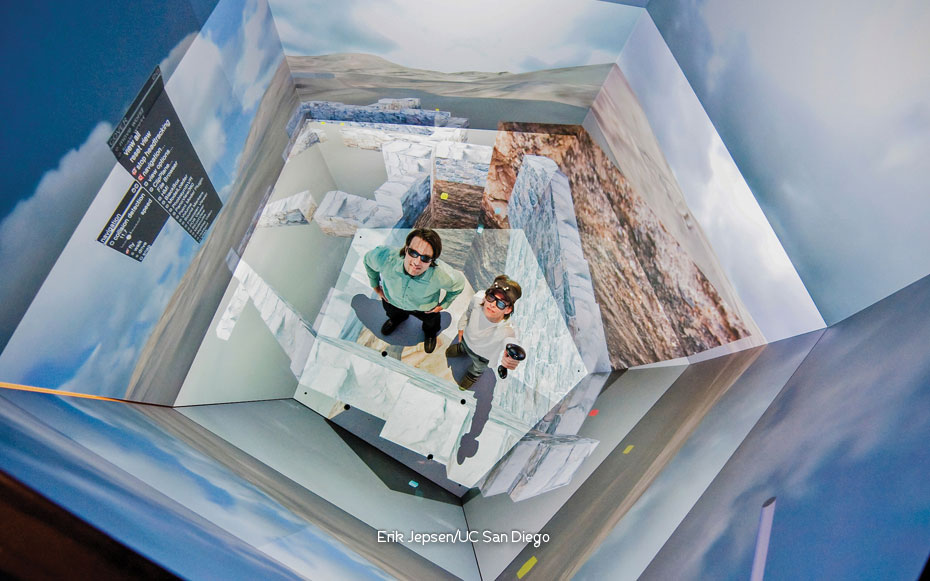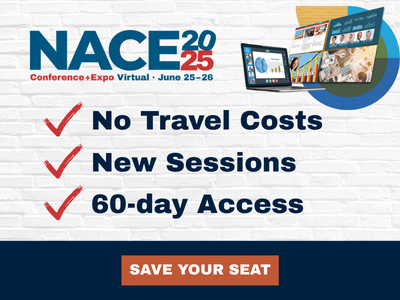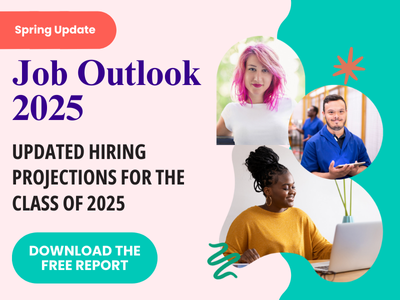NACE Journal / Spring 2024
Picture this: The traditional campus, once defined by ivy-clad walls and impressive lecture halls, is now a living ecosystem pulsating with the rhythm of innovation. The ivory tower is giving way to an open expanse where the frontier between learning and real-world application blurs into a focal point of experiential education. Welcome to higher education, where the rhythms of change are not just heard but felt—where student employment is not a footnote but is transformative.
Student employment emerges as a potent yet often underestimated catalyst for transformative learning experiences. While traditionally relegated to the sidelines of institutional priorities, the University of California San Diego (UC San Diego) student employment program holds unparalleled potential to shape not only academic journeys but also the future careers of countless individuals.
This article seeks to illuminate the often-overlooked significance of student employment, positioning it as a strategic imperative for colleges and universities. We advocate for a paradigm shift that recognizes that elevating student employment to a central role in institutional strategies is not just beneficial but imperative for fostering holistic student development and preparing a workforce that excels in the 21st century. Put simply, student employment, when strategically integrated and thoughtfully reimagined, becomes a powerful force in shaping the educational and professional landscape for both students and institutions alike.
The recommendations presented here are intended as a strategic blueprint. Through strategic alignment, innovative practices, and a commitment to inclusivity, we can collectively sculpt a future where student employment stands not just as a footnote but as a cornerstone in the holistic education of our future leaders.
Resilience Is Essential
Resilience has become essential for navigating the uncertainties of the future of work and embracing innovation as a mindset. As the definition of careers continues to evolve, individuals must not only master a specific skill set but also engage in ongoing learning, adaptation, and resilience that resonates in the ever-changing world of work.
The call to reimagine professional development extends across the student life cycle to student employees contributing to diverse roles across institutions. We must recognize the unique challenges and opportunities that shape their experiences. Student employees are not mere observers but active contributors to the institutions they serve. The professional journey lives between academic commitments and hands-on experiences, and the need for inclusive and innovative development practices is paramount to unlocking students’ full potential.
By emphasizing both personal and professional development, institutions ensure that the skills student employees acquire resonate not only within the confines of a job description but also contribute to their lifelong career and personal aspirations.
The Skills-First Playbook
Skills are the passport to the future. In the ever-evolving landscape of the 21st century, the ability to adapt and thrive hinges not on fixed knowledge, but on the dynamic currency of skills.
As students navigate their educational odyssey, they are not just accumulating knowledge for a singular destination but actively molding their careers and lives. This perspective transforms student employment into a lens through which they not only envision their first job but also embark on a lifelong pursuit of transferable skills, happiness, and purpose.
The skills-first playbook propels students beyond the traditional confines of success, urging them to focus on meaning. It invites them to celebrate diversity, relish small victories, learn from setbacks, and build resilience. In this paradigm shift, the emphasis is not solely on the destination but on the richness of the journey—a journey marked by the pursuit of skills, the cultivation of happiness, and the discovery of purpose.
The Blueprint for Student Employment
There is a symbiotic relationship between skills development and meaningful opportunities. This concept transcends traditional career pathways, fostering an environment where every student is empowered to architect their own future.
The blueprint for student employment advocates for personalized learning journeys, acknowledging that each student's career trajectory is unique. It introduces innovative models that intertwine academic rigor with real-world application, ensuring that students not only grasp theoretical concepts but can seamlessly translate them into actionable skills.
This blueprint is a call to action, inviting educational institutions, employers, and students to co-create an ecosystem where the acquisition and application of skills become integral to the educational journey. It's time to embrace a future where every student is a designer of their career and life.
In the pursuit of reimagining student employment, a strategic plan serves to guide institutions toward a skills-first paradigm. This plan must go beyond conventional approaches, aligning with the dynamic needs of the workforce and the aspirations of the students. As we reinvent student employment, we remind ourselves that innovation is not just a process; it is a mindset.
This strategic plan is not just a strategic plan, it is a reimagination blueprint. It focuses on creating an ecosystem where skills are not just acquired but are nurtured and applied in real-world scenarios. Through strategic partnerships, mentorship programs, and immersive learning experiences, we can ensure that our students are not just employable but are equipped to thrive.
To effectively reimagine the student employment experience, we must begin with the big picture—the guiding principles.
University of California has paved a rich tradition of impacting access and affordability for students and families for its campuses by establishing a combination of four strategic priorities that provide increased financial aid for low-income students, debt reduction/elimination plans, fixed tuition over four years, and expanded financial aid for middle-class families. With access and affordability as the primary pillars, the mission of UC San Diego is to transform California and a diverse global society by educating, generating, and disseminating knowledge and creative works, and engaging in public service.
How does student employment connect with the university’s strategic plan? Because our student employment program is embedded within the career center, we redefined and realigned the career center’s mission, vision, and values to fully support students as they transform their lives from college to career. The career center’s vision is to reimagine the landscape of the global workforce by ensuring that all UC San Diego graduates create purpose and align fulfilling work. Our mission is to empower students to proactively design their careers and lives to align meaningful opportunities throughout their lifetimes.
The career center’s work is guided by the following five strategic pillars: 1) career and experiential learning integrated into the student experience; 2) holistic career education and development; 3) rich and relevant data that inform strategy; 4) recruitment that is optimized, expanded, and diversified through relationships, not contacts; and 5) new and innovative infrastructure, technology, and programming.
Based on this strategic landscape, student employment is not only viewed as a financial aid program, but as a career development learning experience where our students have agency in their career and professional development. By embracing this holistic perspective, we instill a sense of belonging in our student employees, positioning them as active participants in their educational and professional journeys, and ensuring that their employment experience aligns seamlessly with our commitment to equity, diversity, and inclusive excellence.
Integrative Learning and Student Employment
Integrative learning stands as a cornerstone in the contemporary educational paradigm, emphasizing the interconnectedness of academic knowledge, practical experiences, and personal development. This comprehensive approach to education recognizes that true understanding and mastery of knowledge go beyond the limitations of courses, fostering a deep and interconnected understanding of the world. The importance of integrative learning lies in its ability to prepare students for the complexities of the modern workforce. Employers seek individuals who not only possess specialized expertise but also exhibit adaptability, critical thinking, and the capacity to solve complex problems. Integrative learning cultivates these essential skills by encouraging students to explore the intersections of their academic disciplines and engage in experiential learning opportunities.
Moreover, integrative learning fosters a sense of relevance and purpose in education, empowering students to connect their academic experiences to their personal and professional aspirations.
In the context of student employment, integrative learning takes on added significance. As students engage in work experiences, internships, and other forms of applied learning, they have the opportunity to bridge the gap between theory and practice. Integrative learning within the realm of student employment means that the skills acquired on the job become an integral part of the students' overall educational experience. It transforms the workplace into a learning laboratory environment, where students can apply theoretical knowledge, refine their skills, and gain a deeper understanding of their chosen field.
The Catalyst to Student Success
The traits of high-impact practices in higher education provide a useful framework to build an intentional student employment program that is meaningful and impactful for student success and learning. Research has shown students gain more from their college experience when they engage in high-impact practices.1 In a structured learning environment, student employment becomes an important high-impact practice that positively influences retention and graduation rates by facilitating essential experiential learning opportunities for students that deepen their connections to faculty, staff, and students throughout the university.
Universities that are intentional about integrating career development and student employment into their strategy are able to use their student employment program to provide students with meaningful learning and engagement opportunities that strengthen retention and build career-readiness skills. Compared with their peers who work off campus, students who hold on-campus jobs have higher academic success rates, deeper connections to the campus community, and higher persistence rates.2 As student employment also includes the Federal Work-Study Program, student employment is financial aid that provides students who have financial need an opportunity to reduce their student loan debt and earn money toward their education. Student employment directly impacts equity by providing financial assistance and work-based learning to underrepresented students with financial need.
In 2019, NASPA published a report that provides schools with insight into the strengths, weaknesses, challenges, and opportunities for university student employment programs.3 The report identified equipping students with career-readiness competencies, improving students’ financial security and retention/completion, and building students’ connection to campus as the top priorities for student employment programs. The report also identified increasing the number of available student employee positions, collecting and analyzing data, and increasing the number and quality of professional development opportunities for student employees as the top three areas of investment for public four-year universities. In terms of barriers to advancing student employment, three of the top four barriers for public four-year universities included a lack of clear vision or plan for student employment, a lack of standardization and consistency of practices across campus, and time and capacity of full-time staff. Those are also barriers that have existed at UC San Diego and were the catalyst for reimaging the student employment program.
Elevating Student Employment: A Strategic Imperative
Is student employment in the spotlight at most colleges and universities? We believe that most experts would say it is not. Quite often, the student employment program is in the background, even though it provides valuable experience to students and is a vital service for the institution. If the student employment program is not an integrated part of an institution’s strategic plan, it can easily be overlooked and undervalued regarding its contribution to student career readiness and the overall educational experience. By developing an intentional strategy, institutions can improve the student experience, positively impacting retention, student success, and career readiness throughout students’ tenure at the institution.4
The question colleges and universities need to address is: Is our student employment program a hidden gem that provides our students with the ability to unlock their potential?
To address this ambitious challenge, institutions must recognize the transformative potential of student employment and position it as a cornerstone in the holistic development of their students. By acknowledging the strategic importance of the student employment program and strategically positioning it within the institutional framework, colleges and universities can unlock a wealth of benefits that extend far beyond the immediate student experience.

Best Practices in Student Employment
Implementing best practices in student employment is essential for maximizing the positive impact on student development and institutional success. Drawing from successful models and proven strategies, institutions can create an environment where student employment becomes a transformative force. Below is a high-level checklist:
Structured onboarding and orientation: Develop a comprehensive onboarding and orientation process for student employees. This should include an introduction to the institution's values and expectations and a clear understanding of how the student’s role contributes to their academic and professional growth.
Integration with academic curriculum: Explore ways to integrate student employment experiences with the academic curriculum. This can involve faculty collaboration, capstone projects tied to employment roles, or academic credit for certain job responsibilities.
Mentorship and guidance programs: Establish mentorship programs that pair students with experienced staff or faculty members. This not only provides valuable guidance but also fosters a sense of community and support within the institution.
Consistent performance feedback and evaluation: Implement regular performance feedback sessions to help students understand their strengths and areas for improvement. Evaluation processes should be constructive, emphasizing skill development and goal setting.
Incorporate technology for skill tracking: Leverage technology to track and assess the development of skills and competencies. Digital platforms can streamline the self-evaluation process for students and facilitate more efficient evaluations by supervisors.
Promoting justice, diversity, equity, and inclusion: Ensure that student employment opportunities are accessible and inclusive for students from diverse backgrounds. Implement practices that actively promote diversity and create an environment where all students feel valued and represented.
Connecting student employment with career services: Establish strong connections between student employment programs and career services. This includes providing resources for resume building, interview preparation, and career counseling to help students transition smoothly from academic life to the professional world.
Flexibility and adaptability: Recognize the diverse needs and aspirations of student employees. Offer flexible work arrangements, including part-time positions and remote work options, and opportunities for skill development that align with students' evolving career goals.
By incorporating these best practices, institutions can enhance the overall impact of their student employment programs, creating an environment where students not only earn income but also develop crucial skills, build meaningful connections, and prepare for successful careers.
Challenges in Implementing Transformative Changes
While the vision of reimagining student employment is compelling, institutions may encounter challenges in implementing transformative changes. Identifying and addressing these is crucial for ensuring the success and sustainability of an evolved student employment program. Here are eight challenges that we have encountered:
Resistance to change is a common obstacle in higher education. Faculty, staff, and administrators may be accustomed to traditional models of student employment, making it essential to communicate to them the benefits and long-term value of reimagining these programs.
Resource constraints, both financial and personnel, can pose challenges in implementing new strategies. Institutions must explore creative solutions, seek external partnerships, and prioritize student employment within budgetary considerations.
Aligning with institutional culture involves garnering support from leadership, faculty, and other stakeholders to ensure that the vision aligns with the overarching goals and values of the institution.
Ensuring equitable access involves addressing systemic barriers and promoting inclusivity to ensure that reimagined student employment opportunities are accessible to all students.
Balancing academic and work responsibilities requires collaboration with faculty to create flexible schedules and establishing clear expectations for students participating in employment programs.
Measuring and demonstrating the impact of reimagined student employment programs effectively is essential for gaining support and resources. This may involve developing comprehensive assessment strategies and using data to showcase success stories and outcomes.
Engaging employers and industry stakeholders in meaningful partnerships is crucial to success. Institutions must involve external partners in the design and implementation of these initiatives to ensure alignment with workforce needs.
Sustaining momentum beyond leadership changes requires embedding the vision and strategies into the institutional fabric. This involves developing succession plans and ensuring that key principles continue to guide program development.
By addressing these challenges, institutions can navigate the complexities of reimagining student employment and create a resilient and adaptive framework that benefits both students and the broader educational community.
Professional Development for Student Employees
In accordance with the career center’s strategic plan, the Student Employment Professional Development Program was designed as a robust learning lab for students that impacts career readiness and builds transferrable skills and competencies. The program:
- Is student-centric, with a focus on equity;
- Positively impacts student success;
- Reflects real workplaces and culture;
- Leverages the career center ecosystem;
- Links to the UC San Diego Core Competencies and co-curricular record;
- Focuses on transferable skills that help build a career portfolio;
- Builds relationships and expands professional networks;
- Facilitates a learning lab environment that promotes lifelong learning; and
- Promotes a culture of success and amplifies student success stories.
In addition to the checklist developed for our Triton Career Readiness Passport, our team developed a series of pre- and post-employment toolkits and checklists for student employees that guide them through the application process and provide them with everything they need to complete the onboarding process with the hiring department; using the university staff’s onboarding processes for student employees is recognized as a best practice by NASPA.5 We also leverage the UC learning management system (UC Learning) to administer required training for all staff and student employees.
After students are onboarded, they meet with their supervisor and receive department-specific training pertaining to the job responsibilities. Department supervisors also use the UC Learning asynchronous training modules to augment the students’ professional development with workshops on professionalism; equity, diversity, and inclusion in the workplace; communication; collaboration; and more. The department supervisor then helps the students draw the connections from the work they are doing in the department to the UC San Diego competency framework through regular check-ins during the year.
Toward the end of the academic year, student employees complete a self-evaluation, and the supervisors complete an evaluation for each of their student employees. Both evaluations are based on the UC San Diego competencies and serve as tools to continue the discussion between the student employee and their supervisor. These conversations help students reflect on their work, what they are learning, what projects they enjoy or do not enjoy working on, and areas of growth and improvement. Ideally, these are the mentoring conversations supervisors have with their student employees to help them connect the skills and competencies they are developing through their work in the department.
Breaking Barriers: Inclusive Ecosystems and Mental Resilience
Many students struggle with aligning a career and life vision. According to one study, a lack of career direction and clarity increased psychological problems, anxiety, and/or depression that impacted the overall well-being of late adolescent participants.6 This research underscores the mental health challenges associated with the employment struggles faced by college graduates, emphasizing the need for innovative solutions within student employment programs. In a 2022 study conducted by McKinsey & Company, Americans ages 18 to 24 reported high rates of mental health challenges, including obstacles to working effectively, worrying about the past, and finding a sense of belonging. Gen Z participants in the survey also reported high levels of negativity about themselves, a lack of confidence, and a lack of meaning and satisfaction.7 This is a wake-up call for career centers.
By fostering a supportive and holistic environment, the student employment program not only arms students with the necessary skills for the job market but also prioritizes their mental health, acknowledging and mitigating the stressors inherent in the career development process. This approach aims to create a more compassionate and empathetic space within the career center, fostering a positive impact on the overall well-being of participating students.
We are currently exploring a partnership between our career center; mental health services, including counseling and psychological services (CAPS); and the Office for Students with Disabilities (OSD). This collaboration aims to explore new ways to empower Gen Z with the necessary resources and support to navigate the working world with confidence and resilience.
The career center's alliance with OSD demonstrates a commitment to dismantling barriers and ensuring equal opportunities for all students, regardless of their unique challenges. The partnership with CAPS reflects a holistic approach to student success, acknowledging the crucial intersection between mental health and career readiness.
Through this collaborative effort, UC San Diego is not only addressing the concerns highlighted in the McKinsey study but also is taking steps to create an environment where every student can thrive. We aim to build a culture of support, understanding, and accessibility. By partnering with each other and our students, we can reshape a new world of work that is inclusive, accessible, and sustainable for all.
Disrupting the Student Employment Paradigm
To disrupt the student employment paradigm is to challenge the status quo. Disruption is not chaos; it is the catalyst for evolution. By redefining how students perceive employment, we pave the way for a future where each professional pursuit is an opportunity for growth, exploration, and fulfillment.
Anticipating future trends and addressing emerging challenges is essential for staying ahead of the curve and ensuring that student employment remains a dynamic and relevant component of the educational experience. To that end, institutions can:
- Explore the implications of remote work and virtual collaboration on student employment. Institutions can consider how to leverage technology to provide flexible opportunities and prepare students for the evolving landscape of remote work.
- Investigate the potential impact of artificial intelligence and automation on student employment. Institutions can develop strategies to integrate AI-related skills into student employment opportunities, ensuring that students are equipped to navigate the evolving technological landscape.
- Shift the focus from short-term employment gains to the cultivation of lifelong learning skills. Institutions can design student employment programs that instill a commitment to continuous learning, adaptability, and resilience. They can also empower students to view each employment opportunity as a steppingstone in their lifelong journey of skill acquisition and personal development.
By charting a course that embraces these future directions, institutions can shape student employment into a compelling force, preparing students not just for their first job but for a lifetime of meaningful contributions and continuous growth. As the educational landscape evolves, so too can student employment, becoming a pre-career and professional development preparedness program.
Endnotes
1 Kuh, G., (2009). High-Impact Practices: What Are They, Who Has Access to Them, and Why Do They Matter. AAC&U, Washington, D.C.
2 Cramer, S., & Kulm, T. L. (2006). The Relationship of Student Employment to Student Role, Family Relationships, Social Interactions and Persistence. College Student Journal, 40(4), 928–938.
3 Burnside, O., Parnell, A., Wesaw, A., Wesley, A. (2019). Employing Student Success. A Comprehensive Examination of On-Campus Student Employment. National Association of Student Personnel Administrators (NASPA), Inc.
4 McClellan, G. S., Creager, K., & Savoca, M. (2018). A Good Job: Campus Employment as a High-Impact Practice. Sterling, VA: Stylus.
5 Burnside, et al.
6 Kunnen, E.S. (2014). The effect of a career choice guidance on self-reported psychological problems. Retrieved from www.ncbi.nlm.nih.gov/pmc/articles/PMC4045055/.
7 McKinsey & Company. (2022, October 19). How Does Gen Z See Its Place in the Working World? With Trepidation. Retrieved from www.mckinsey.com/featured-insights/sustainable-inclusive-growth/future-of-america/how-does-gen-z-see-its-place-in-the-working-world-with-trepidation.







